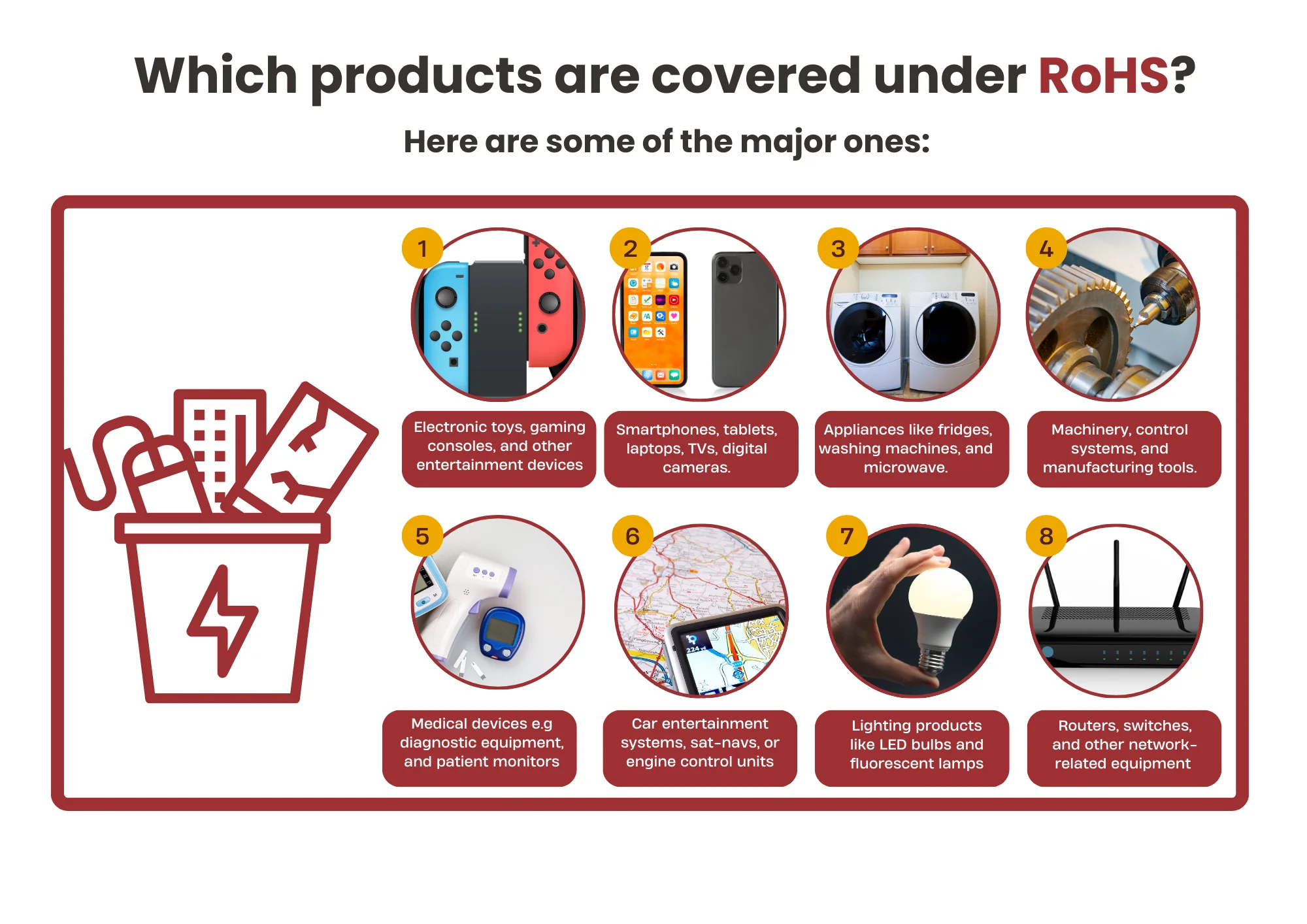
What does RoHS mean?
RoHS, officially known as the "Restriction of Hazardous Substances Directive," is a regULation aimed at limiting the use of specific hazardous substances in electrical and electronic products. JJR Laboratory, as a professional testing institution, has conducted in-depth research on the RoHS directive and provides businesses with detailed and accurate regulatory interpretations, helping them understand the specific requirements and significance of ROHS Testing.

The European Union implemented the first version of the RoHS directive (RoHS 1.0) on July 1, 2006, which explicitly restricted the use of six hazardous substances, including lead (Pb), cadmium (Cd), mercury (Hg), hexavalent chromium (Cr6+), polybrominated biphenyls (PBBs), and polybrominated diphenyl ethers (PBDEs). Products that violate these restrictions may face severe penalties when exported to the EU.
RoHS 2.0
On June 4, 2015, the EU updated RoHS 2.0 through Directive (EU) 2015/863, adding four phthalates (DiBP, DBP, BBP, and DEHP) to the restricted substances list, increasing the total number of restricted substances to ten.
Beyond the EU, multiple countries and regions worldwide—including China, the United States, Japan, and South Korea—have also implemented similar RoHS regulations, making RoHS Compliance a fundamental requirement for electronic and electrical products to enter international markets.
Importance of rohs testing
1. The Necessity of RoHS Testing
Conducting RoHS testing is crucial for manufacturers, as non-compliant products may face market rejection or legal and financial consequences. JJR Laboratory is equipped with advanced instruments and an experienced technical team, offering comprehensive, fast, and professional one-stop services. Our laboratory information management system ensures high efficiency and accuracy in test data and reports.
2. Product Categories Regulated Under RoHS 2.0
- Large household appliances
- Small household appliances
- IT and telecommunications equipment
- Consumer equipment
- Lighting equipment
- Electrical and electronic tools
- Toys, leisure, and sports equipment
- Medical devices
- Monitoring and control instruments
- Automatic dispensers
- Other electrical and electronic equipment
RoHS 1.0 and China RoHS
With its advanced equipment and professional team, JJR Laboratory efficiently conducts RoHS testing for manufacturers, ensuring compliance with regulations and mitigating legal and econoMIC risks.
1. The Six Restricted Hazardous Substances and Their Limits:
- Lead (Pb): 1000 mg/kg
- Cadmium (Cd): 100 mg/kg
- Mercury (Hg): 1000 mg/kg
- Hexavalent Chromium (Cr6+): 1000 mg/kg
- Polybrominated Biphenyls (PBBs): 1000 mg/kg
- Polybrominated Diphenyl Ethers (PBDEs): 1000 mg/kg
2. RoHS 2.0 Updates
RoHS 2.0 expanded the restricted substances list by adding four phthalates, with limits set at 1000 mg/kg or 100 mg/kg.
RoHS 2.0 Testing Items and Methods
RoHS 2.0 testing includes lead, cadmium, mercury, hexavalent chromium, polybrominated biphenyls, polybrominated diphenyl ethers, and the four restricted phthalates. The testing methods and instruments used include:
- ICP-OES testing according to IEC 62321-5:2013
- ICP-OES testing according to IEC 62321-4:2013+AMD1:2017CSV
- UV-VIS testing according to IEC 62321-7-1:2015
- GC-MS testing according to IEC 62321-6-2015
- GC-MS testing according to IEC 62321-8-2017
Hazardous Substance Detection Methods and Limits
To ensure compliance with environmental regulations, specific hazardous substances must undergo testing. The following are the detection methods, instruments used, and corresponding limits:
1. Heavy Metal Detection
- Lead (Pb):
- Standard: IEC 62321-5:2013
- Instrument: ICP-OES
- Detection Limit: 10 mg/kg
- Regulatory Limit: 1000 mg/kg
- Cadmium (Cd):
- Standard: IEC 62321-5:2013
- Instrument: ICP-OES
- Detection Limit: 10 mg/kg
- Regulatory Limit: 100 mg/kg
- Mercury (Hg):
- Standard: IEC 62321-4:2013 + AMD1:2017
- Instrument: ICP-OES
- Detection Limit: 10 mg/kg
- Regulatory Limit: 1000 mg/kg
- Hexavalent Chromium (Cr⁶⁺):
- Standard: IEC 62321-7-1:2015 & IEC 62321-7-2:2017
- Instrument: UV-VIS
- Detection Limit: 0.10 µg/cm² or 20 mg/kg
- Regulatory Limit: 1000 mg/kg
2. Brominated Compound Detection
- Polybrominated Biphenyls (PBBs):
- Standard: IEC 62321-6:2015
- Instrument: GC-MS
- Detection Limit: 100 mg/kg
- Regulatory Limit: 1000 mg/kg
- Polybrominated Diphenyl Ethers (PBDEs):
- Standard: IEC 62321-6:2015
- Instrument: GC-MS
- Detection Limit: 100 mg/kg
- Regulatory Limit: 1000 mg/kg
3. Phthalates Detection
- Diisobutyl Phthalate (DiBP):
- Standard: IEC 62321-8:2017
- Instrument: GC-MS
- Detection Limit: 50 mg/kg
- Regulatory Limit: 1000 mg/kg
- Dibutyl Phthalate (DBP):
- Standard: IEC 62321-8:2017
- Instrument: GC-MS
- Detection Limit: 50 mg/kg
- Regulatory Limit: 1000 mg/kg
- Benzyl Butyl Phthalate (BBP):
- Standard: IEC 62321-8:2017
- Instrument: GC-MS
- Detection Limit: 50 mg/kg
- Regulatory Limit: 1000 mg/kg
- Di(2-ethylhexyl) Phthalate (DEHP):
- Standard: IEC 62321-8:2017
- Instrument: GC-MS
- Detection Limit: 50 mg/kg
- Regulatory Limit: 1000 mg/kg
Email:hello@jjrlab.com
Write your message here and send it to us
 What Are the Testing Items of California Propositi
What Are the Testing Items of California Propositi
 E-Cigarette EU TPD Testing
E-Cigarette EU TPD Testing
 Testing Certification for E-cigarettes Exported to
Testing Certification for E-cigarettes Exported to
 What is Amazon US CPC Certification?
What is Amazon US CPC Certification?
 UK Toy Safety Regulation Standard EN 71-13
UK Toy Safety Regulation Standard EN 71-13
 What is EU UFI Registration?
What is EU UFI Registration?
 EU UFI Registration for E-cigarette E-liquid
EU UFI Registration for E-cigarette E-liquid
 How to get the MSDS Report for Electronic Cigarett
How to get the MSDS Report for Electronic Cigarett
Leave us a message
24-hour online customer service at any time to respond, so that you worry!




